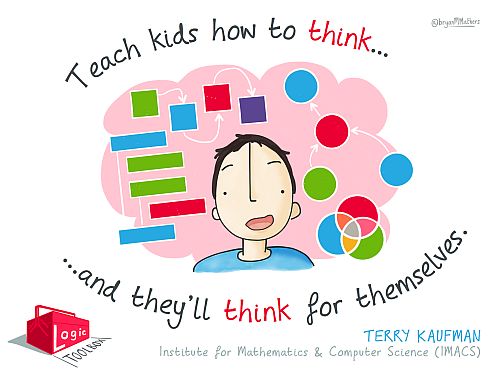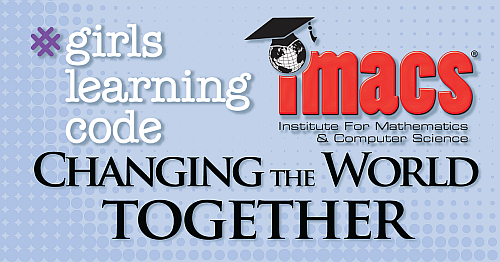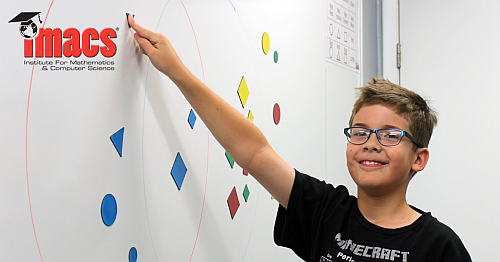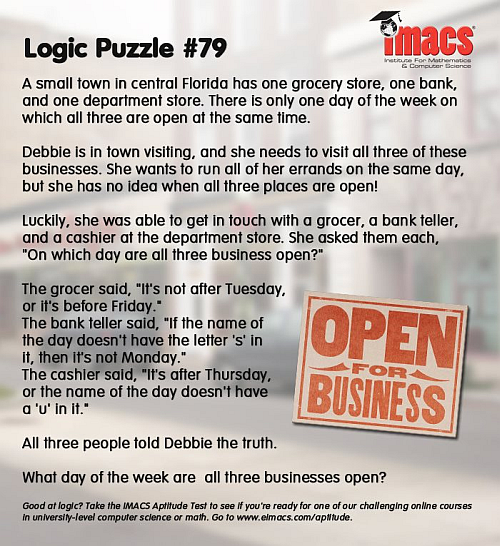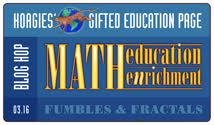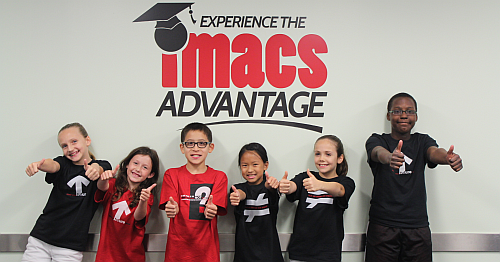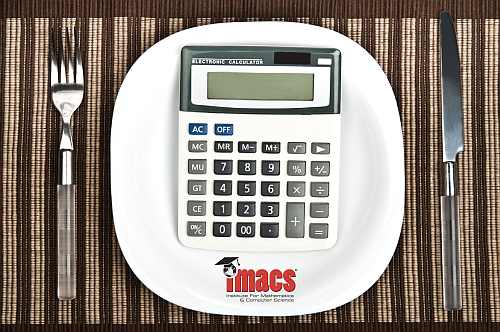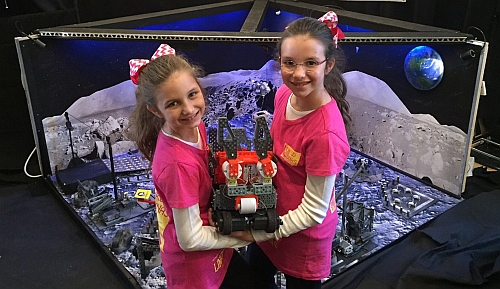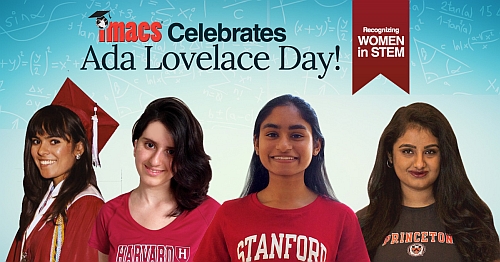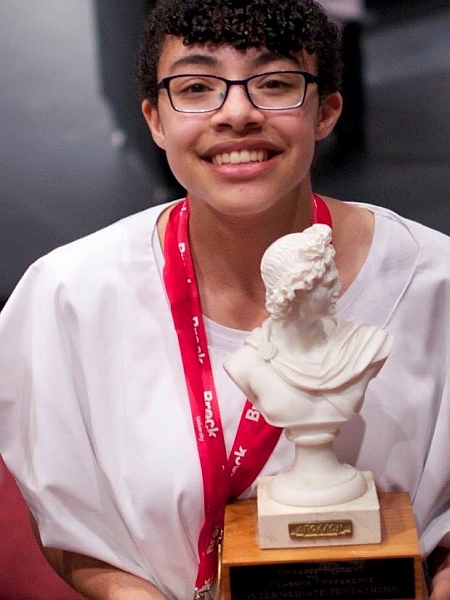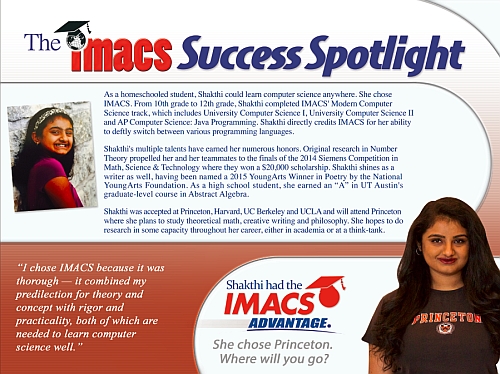
As parents we instinctively want to help our children when they struggle. Our impulse is often to just fix the problem ourselves. While this approach makes sense when children are very young, as they grow it becomes counterproductive. In rescuing our kids, we provide a quick fix but deny them opportunities to practice important skills that they will need to become independent adults.
This is true in general and certainly with respect to education. As children grow, we should encourage them to develop the thinking skills that they will need in college and in their chosen careers. In what may seem like counterintuitive advice, teaching kids to think sometimes involves parents doing less, not more. Here are five tips on how parents can help children learn to think for themselves.
1. Don't be so quick to offer help. If your child asks you for help with school work, first consider how much independent effort she has truly given before turning to you. In a world of online programs that provide hints at the click of a button, it's easy to fall into the trap of thinking that getting to the answer quickly is good and struggling is bad. But math education research shows that a healthy amount of struggle actually leads to deeper learning. By answering your child's questions too soon, you can adversely affect how well she learns. Instead, remind her that it is perfectly normal to take a good amount time to work through problems, allow sufficient time in her schedule to do so, and encourage her to be patient with herself. Once you sense that she has put in a reasonable amount of independent effort on a problem, it's okay to offer hints that give just enough information to get her thinking again without giving away too much.
2. Don't point out mistakes before children have had a chance to discover the mistakes themselves. When you point out mistakes to your child too soon, he is less likely check his own work because he knows you'll do it for him. You also curtail the learning and brain growth that happens when he has to determine on his own that he made an error and what the error is. Finally, you may be signaling that you disapprove of making mistakes, which can lead to other problems such as an unwillingness to try challenging activities. When it's time to bring mistakes to your child's attention, a better way is to let him know that he has made at least one error but not tell him what, where, or how many. This approach necessitates that he will have to look carefully over all of his work and encourages the good habit of doing so on his own as he gets older.
3. Do encourage children to correct their mistakes. Too often, bright students just want to forget about the mistakes they make on school work, especially if they have been led to believe that smart people don't make mistakes. But a mistake means that the problem was challenging for your child, so she should definitely look back at it and work to correct her understanding. Often times we learn better from mistakes than from successes, and research shows that our brains actually grow more from making and correcting mistakes. Help your child see the good in mistakes by using them as opportunities to learn more.
4. Do ask open-ended questions. Asking questions is a highly effective way of guiding your child to think his own way to the answer — What information do you have? What information are you missing that could be helpful? How can you break up the problem into more manageable pieces? When your child was young, he probably asked you a lot of "Why?" questions. As he gets older, turn the tables and ask him why in the same inquisitive, non-judgmental way. Why do you make this assumption? Why do you take that approach? Why does this lead to that? As you know from being on the answering end of "Why?" questions, formulating a thoughtful response takes effort. For a growing mind, that's a good thing. One caveat: Be sure to avoid doing the thinking for your child by giving away too much information in the form of a question such as, "Shouldn't you combine like terms first?"
5. Do provide challenges that require deep thinking. Just as your muscles won't grow from lifting light weights, your child's thinking skills won't develop from doing easy problems. What's more, curious, young minds are naturally engaged by interesting, hard problems as long as those minds are not yet overcome with a fear of making mistakes. Intellectual challenges also provide opportunities to develop good study habits, resiliency from surviving the inevitable mistakes, and genuine confidence that comes from knowing you can handle hard problems.
Ladies Learning Code and the Institute for Mathematics and Computer Science (IMACS) are partnering to award over $3,000 in scholarships to participants in the 2016 Girls Learning Code Camps and members of GLC’s Teen:Club. The two full and three half scholarships will allow recipients to enroll in IMACS’ introductory computer science course, University Computer Science I (UCS1).
240 girls ages nine to twelve are expected to attend Girls Learning Code Camps in Toronto this March and Summer. The camps are designed to help girls see technology in a whole new light — as a medium for self-expression, and as a means for changing the world. IMACS will award one full scholarship and one half scholarship among applicants who attend the camps. All campers are invited to apply.
Shuli Jones attended the very first Girls Learning Code camp as a 6th grader back in 2012 where she won a half scholarship to UCS1. She is now a sophomore in high school and recently scored a ‘5’ on the AP Computer Science A exam as a freshman. Since starting IMACS’ computer science courses soon after the camp, Shuli has been one of IMACS’ top CS students.
IMACS will award the other full scholarship and two half scholarships to members of GLC’s Teen:Club. In Teen:Club, 13 to 17 year old girls focus on solving problems, turning ideas into reality and learning about what a future in technology could look like. All members are invited to apply.
"Now that we have been running youth programs for 4 years, we are really starting to see our participants move on to technical career paths, pursuing Computer Science in University and coming back to participate in our programs as mentors, inspiring the next generation of girls," says Laura Plant of Ladies Learning Code. "We’re excited for our girls to have an opportunity to study computer science at a high level with IMACS."
"IMACS believes in the potential of bright girls and young women to shape a better future for all people," adds IMACS president Terry Kaufman. "We are thrilled to be working with Ladies Learning Code again to encourage more girls to pursue computer science in college and in their careers."
Scholarship Information
The course, UCS1, is a challenging and engaging introductory programming course that gives students the tools they need to excel as a computer science major in college. UCS1 teaches the fundamental principles of computer science at the university level but was developed for talented middle and high school students.
Scholarship applicants must submit a 100-250 word essay to Ladies Learning Code on what they hope to get out of this program. They are also required to pass the online eIMACS Aptitude Test. The application deadline for these scholarships is August 31st 2016.
Applicants may register for the eIMACS Aptitude Test at www.eimacs.com/aptitude. On the online registration form, enter "Girls Learning Code 2016" in the box for "How did you hear about IMACS?"
About Ladies Learning Code
Ladies Learning Code is a Canada-wide not-for-profit organization that runs workshops for women and youth who want to learn beginner-friendly computer programming and other technical skills in a social and collaborative way. Today they have 22 chapters (and counting) across Canada, a thriving girls’ program called Girls Learning Code and co-ed kids program called Kids Learning Code. With sponsors and community partners that include TELUS, Microsoft, Facebook, Autodesk, Google and many more, Ladies Learning Code has become synonymous with technology education in Canada.
About IMACS
Founded in 1993 by a team of mathematicians, computer scientists and educators, IMACS offers talented middle and high school students a range of online courses in university-level mathematics and computer science that are recognized by many prestigious universities. IMACS also offers math and computer enrichment classes at its US centers in Florida, North Carolina, Missouri, and Connecticut. Over 4,500 students throughout the US and the world attend local IMACS classes or study its online courses. For more information on IMACS visit www.imacs.org.
Contact
For Ladies Learning Code:
Laura Plant, Co-Executive Director
laura@ladieslearningcode.com
416-579-9809
For IMACS:
Natasha Chen, Communications Director
nchen@imacs.org
954-791-2333
Logic is the systematic study of reasoned argument. Why study logic? For students planning to take university-level math courses, which typically involve reading and writing proofs, the benefits are evident. But even for students heading in a different direction, developing strong logical reasoning skills has benefits too.
Logic Supports Learning Mathematics
Few would dispute that arithmetic is a fundamental base upon which the successful learning of math is built. Consequently, the development of arithmetic skills receives enormous attention in elementary school. Logic is equally fundamental to learning all other areas of math but is rarely taught in elementary school. Were students to develop a strong foundation in logic at a young age, their capacity to understand middle and high school math would be greatly enhanced.
In arithmetic, we learn how to combine or break apart numbers in order to proceed from the information given to the answer sought. If we bake three dozen cookies, multiplication tells us how many cookies we have in all. If 17 cookies are left, subtraction tells us how many were eaten. Honing arithmetic skills in elementary school allows students to quickly and accurately call upon them later, thereby making it is easier to learn more advanced math in the future.
Logic is a similarly powerful and essential tool for learning more advanced math. Whereas arithmetic is used in constructing and deconstructing information that is numeric in nature, logic is essential in constructing and deconstructing assertions that are mathematical in nature.
Students typically encounter a weak version of proofs and logic for the first time in high school geometry. But by then, pre-algebra and elementary algebra have already been taught as mostly procedural rules and algorithms to accept at face value. As a result students do not develop a genuine understanding of the derivation of those rules and algorithms and why they work. By the time students reach high school, their natural curiosity about mathematical ideas has been reduced to a hard-to-break habit of memorizing and applying rules blindly.
A worthy goal of the Common Core math standards is to develop mathematical understanding in addition to procedural skills. True mathematical understanding comes with seeing how knowledge is pieced together step-by-step on the path to deriving an important result. This is similar to what we know about developing scientific understanding in young minds — hands-on projects make learning stick better than memorizing facts. Math’s version of "hands-on" is your brain working its way through the reasoning that mathematicians followed in order to provide us with neat and tidy rules.
With a strong foundation in logical reasoning, students would have the key analytical tool needed to work their way successfully through the reasoned arguments that lead to the rules. Some may even wish to achieve the deepest understanding by using logic to independently derive the mathematical truths they were once asked only to memorize.
Logic Supports Complex Problem Solving Beyond Mathematics
The amazing thing about logic is that it makes us better thinkers and problem solvers well beyond mathematics. Computer science could not exist without logic. If you want to understand the underlying principles and algorithms and be able to apply them in any programming environment, you must understand logic. Engineering disciplines rely on logic too, especially electrical engineering as any Minecrafter worth her redstone will tell you. The entire practice of law is founded upon reasoned argument, which is why the LSAT has sections on logical reasoning and analytical reasoning.
People who learn to think logically are better at analyzing complex problems. Mathematics, with its diversity of complex problems, is a natural thought playground for developing logical thinking skills. The first steps in solving any math problem are assessing the situation and coming up with a plan of attack. Can you view the larger problem as a combination of more manageable cases? Can you take what you know and derive what you need to know? Would additional information lead you to certain conclusions? Answering these types of questions requires logical thinking.
People who learn to think logically are also better at assembling solutions. Once you have assessed the problem, broken it down, and gathered the necessary information, how do you put it all together to arrive at a solution? When faced with a novel situation, can you devise an approach where there was not one before? As the pace of change in our world accelerates, every field increasingly needs people who can strongly grasp core concepts and combine them sensibly to solve any problem, especially unfamiliar ones. Learning to apply logical thinking to mathematical situations is excellent training for handling complex problems, no matter which college major or career you choose.
Logic has a way of promoting clarity of thought in understanding ideas that were previously unfocused or muddled. Whether you are planning on becoming a professional mathematician or just trying to get through math homework on your way to a different intellectually demanding career, there is no doubt that strong logical reasoning skills would ease your path.
This blog article is part of the Hoagies' Gifted Education Page March 2016 Blog Hop on Math Education Enrichment. Please click on the Blog Hop image above to learn more about Math Education Enrichment from other Hoagies' Blog Hop participants.
—Keith Devlin, Professor of Mathematics, Stanford University
Several of our Math Enrichment parents have asked why IMACS wasn’t mentioned in The Atlantic’s recent article entitled "The Math Revolution". Well, we’re the first to admit that we’re not sexy! To journalists, that is. Or rather what we do isn’t sexy, especially when compared to the panache of producing math competition winners. But we believe in what we do, which is more than just math. IMACS prepares children to be better thinkers for life. And after twenty-three years of seeing our approach succeed, we wouldn’t change for all the media coverage in the world.
For readers unfamiliar with IMACS, we specialize in mathematics and computer science for bright, talented and gifted K-12 students. The core of our program is our Mathematics Enrichment curriculum for elementary school students, which is taught at 29 locations throughout the US. IMACS Math Enrichment is unique in that it is intentionally designed to be completely different from school math. One might say it’s "mathematician" math because it teaches even our youngest students about beautiful and powerful mathematical structures studied by professional mathematicians and typically not introduced until college.
Why do we take this approach instead of starting with what kids have already seen and expanding on it? (It sure would be a lot easier on us to market curriculum that parents recognize and that journalists think they can write about!) This goes back to the overarching purpose of everything we do — making better thinkers for life. We’re not just about turning good math students into even better ones, although we do that. We’re not just about providing gifted students with an outlet for their creative mathematical thinking, although we do that a lot. We’re not just about teaching problem-solving skills, although we certainly do that. IMACS is about teaching children how to think in creative, logical and flexible ways that will benefit them throughout their lives, whether within or outside the mathematical arena. We equip them so that, long after they have left our classrooms and entered into the "real world", they will be able to react intelligently and constructively to problems and situations that no one alive today has even imagined.
How do you learn to face those kinds of novel situations? Not by working on problems that look familiar. As IMACS alumnus Zachary Kaufman put it, "Graduate school at Stanford was so much easier with the logical thinking skills I learned at IMACS. While classmates tried to memorize each type of problem, I was able to strongly grasp core concepts and use them to solve any problem, even if it was different from those I had seen." Zachary is a better thinker for life. Or alumna Rachel Cuozzo: "An MIT degree says to the world that you are capable of complex problem solving and abstract thinking. IMACS gave me a jumpstart on my MIT education, as it taught me to exercise the same parts of my mind that I use now on a daily basis." Rachel is a better thinker for life. This is what IMACS is about. Unfortunately, it doesn’t always make good copy in an article about math whizzes.
Furthermore, IMACS has never been only for kids who already excel at math or families seeking a challenging math education for their gifted children. Of course, the majority of our students are very mathematically talented, and they happily attend our Math Enrichment classes or take our online math courses. But IMACS also nurtures bright students with untapped abilities whose prior negative experiences turned them away from math. Usually, they have been misled into thinking that being good at math means calculating quickly, scoring high on standardized math tests, or enjoying math competitions. For many talented students, none of those apply. IMACS is able to take those kids — who often have natural talent for math expressed in other ways, such as a love for games, puzzles and patterns — and show them (1) what it means to be genuinely good at math and (2) how incredibly good at math they truly are. IMACS makes them, too, better thinkers for life.
So if you are a current IMACS parent wondering if you’re missing out on something, or if you are a prospective parent considering IMACS, we encourage you to confirm that the math enrichment providers you are considering actually live up to their claims. Some will tell you that they go beyond what schools do. Some will tell you that they don’t do "drill and kill". Verify for yourself. Ask to observe a class and to see samples of the curriculum. Does it look familiar? Is it largely similar to what schools already teach? That will tell you a lot about whether your child’s mind is going to be expanded as much and in ways that you’re hoping for and quite possibly paying for.
Last New Year’s Eve, Mary, Nancy and Peter each made a different resolution about desserts.
- One of them said "No ice cream."
- One of them said "All of my desserts will have fruit! (That makes it healthy, right?)"
- One of them said "No chocolate."
In January, the three friends went out to eat three times. Loving social media, they each declared their dessert choice online during the meal. During each meal …
- exactly one person kept his or her resolution and was honest about it,
- exactly one person broke his or her resolution and was honest about it, and
- exactly one person broke his or her resolution and lied about it.
Over the three meals, each person took each action once. Here were their declarations:
| Mary | Nancy | Peter | |
| At Meal #1 | peach cobbler | apple pie with vanilla ice cream | chocolate ice cream |
| At Meal #2 | chocolate covered strawberries | plum pudding | peach cobbler |
| At Meal #3 | apple pie with vanilla ice cream | chocolate cake | cheesecake |
For each person, what resolution was made?
Try your best before looking at the solution to this year’s IMACS Holiday Logic Puzzle.
Last week, The Atlantic published an excellent article questioning the trend toward requiring convoluted explanations of mathematical thinking in Common Core-aligned math classes. The authors rightly pointed out that verbal explanations are hardly the only way of determining whether a student understands a concept and that many of the brightest mathematical minds are verbally challenged.
The theory that if you cannot explain, you do not understand does logically lead to the conclusion that if you understand, you can explain. (IMACS Mathematical Logic students will recognize this as an example of contrapositive inference.) That theory, however, is completely false, yet it continues to drive the misguided practices of Common Core-aligned pedagogy to the detriment of another generation of students who, we worry, will be irreparably damaged in their understanding and appreciation of math.
Visual explanations are often a natural way to demonstrate mathematical understanding when designed thoughtfully and taught well, but even they can be gamed. There is another way, however, that is an effective measure of true understanding — demonstrating how well you can apply your knowledge to a novel situation. This approach does not call specifically for a verbal, visual or symbolic explanation, but it does require that teachers have the mathematical depth to recognize understanding when presented in a variety of explanatory modes, not just how a scoring rubric of model answers dictates.
Consider for a moment the art and science of cooking. Some people can only follow a recipe, and many have compared this to when students can only "plug 'n chug" math formulas and algorithms. Some people read cooking magazines or watch the Food Network and then impress with the right vocabulary at parties, the same way verbally skilled students will learn the right Common Core-friendly phrases to use in answering certain types of problems. Then there are the chefs, the ones who understand why certain ingredients and/or cooking methods work well together and what the fancy foodie talk actually means. What can they do with their genuine understanding?
If you've never watched the television show Chopped, take a moment. Competing against the clock and other chefs, each contestant must use everything in a basket of mystery ingredients to prepare an appetizer, entrée or dessert. When the ingredients are unveiled, it is not unusual for them to include such oddities as grasshoppers, gummy bears and leftover pizza. Talk about a novel situation!
It's hard to imagine a single traditional recipe that calls for such ingredients, or what erudite words you could utter about the culinary characteristics of a grasshopper. But leave it to the chefs on Chopped to shred the pizza crust, melt the gummy bears and use them with other ingredients to make breaded and glazed gourmet grasshoppers with a pepperoni pâté!
Mathematics is a lot like cooking. When you have a genuine understanding of mathematical concepts, you know what to do when faced with a problem that is unlike any you’ve seen before but that requires putting your knowledge together in a new way. Whether you can impress the Pulitzer Prize people as well is beside the point. Bon appétit!
You might recognize twin sisters Hadley and Delaney Robertson from their cooking show for kids, Twice as Good, that airs on PBS stations across the country. We at IMACS also have the pleasure of knowing them as two intelligent and delightful students who have been attending our Math Enrichment classes since they were in kindergarten. "IMACS has provided Hadley and Delaney with such an amazing mathematical foundation," their father, Johnathan, recently shared with us. And we are beyond thrilled to share that these talented girls were just named grand prize winners in the 2015 MOONBOTS Challenge!
The international MOONBOTS competition, also known as the "Google Lunar XPRIZE for Kids," is designed to encourage the next generation of space explorers and innovators. Kids ages 8-17 are invited to design, create and program their own lunar rover, based on a legend or theory that inspires them about the moon. This year 235 teams from 29 countries entered the competition, and the Linked Lunas team comprised of Hadley and Delaney won! As grand prize winners, they will travel to Japan to meet the Google Lunar XPRIZE teams that are competing to land a privately funded robot on the moon.
Hadley and Delaney have long been fascinated by the moon. When they were younger, their grandfather would regale them with a story of how the Earth once had two moons, which the sisters imagined were twins like themselves. They later discovered that planetary scientist Professor Erik Ausphaug theorized that the Earth, indeed, used to have two moons that eventually collided and merged to form the moon that we see today. This mythical tale and scientific theory inspired in Hadley and Delaney a deep interest in the moon and thoughts on how the same moon appears differently depending on one’s perspective. They share their inspiration in this clever entry video:
With a captivating presentation like that, it's no wonder that Linked Lunas was one of only 30 teams to move on to the technically challenging second phase of the competition. During the second round, Hadley and Delaney put their engineering, programming, and creative problem-solving skills to work in designing and building a lunar landscape, building and programming a sophisticated robot, and developing a game for their robot to rove the lunar landscape. Not bad for a pair of 9-year-olds! You can’t help but be impressed by their masterful moon mission in this next video:
The MOONBOTS Challenge, however, isn't only about individual achievement. An important component of the competition is how teams use their innovative projects to inspire members of their community through public outreach. Team Linked Lunas was able to secure donations of robotics kits and $5,000 for after-school robotics instruction at a local, underserved middle school. In this last video, Hadley and Delaney give a demonstration of their robot to students from that school and announce the exciting news of the donations to their school:
Everyone at IMACS is so proud of these remarkable girls. There is no doubt that Hadley and Delaney have a talent for math and science and love inspiring others to learn. The cooking show Twice as Good has produced 20 fun videos that explain how cooking can teach kids about nutrition as well as science, math, and geography. Share these with your children and maybe they, too, will be encouraged to shoot for the moon!
October 13, 2015 is Ada Lovelace Day, a day to honor the achievements of women in science, technology, engineering and math. IMACS asks that you join us in celebrating this day by encouraging a girl to pursue her interests in the STEM subjects.
She may be your daughter, sister, student or friend. She may be enthusiastically expressive about her love for STEM, or she may be the quiet type who will share deep thoughts if you ask. Or she may be especially in need of your encouragement because she’s not yet received that message or, worse yet, has been actively discouraged from pursuing her passion for STEM.
What can you do to encourage a girl in STEM today or any day? If you have the knowledge and time to share, become a mentor to her. If you don’t have the time to commit to mentoring, help her find appropriate enrichment activities such as local events at the science museum or after-school programming classes that will keep her engaged, especially when social pressure can push her off track. Even something as simple as sharing stories about talented women in STEM who can serve as role models can make a difference.
IMACS is honored to have been a meaningful part of the education of numerous high-achieving girls who have gone on to amazing college and professional careers. They now serve as inspirational role models for our younger students. Who knows? The girl you encourage today may one day be an IMACS alumna studying STEM at a top university!
as she holds the trophy for winning the Intermediate Pentathlon prize
at this year’s Ontario Student Classics Conference.
This week, the IMACS Blog visits with eIMACS student Shuli Jones. Shuli is one of our star students, having excelled in our university-level computer science courses since the 6th grade. She recently attained the highest score possible on the AP Computer Science A test exam as a high school freshman. A multitalented young lady with a passion for programming, Shuli is well on her way to a bright future.
Please tell our readers a little bit about yourself and what you enjoy doing.
My name is Shuli Jones. I’m fifteen years old, and I’m currently a sophomore in high school. In my spare time, I like to participate in a variety of activities: I love to read, I do archery recreationally, I’m part of a trivia team and a classics society at my school, and, of course, I love programming. I’m also interested in learning new languages, coding and otherwise!
You’ve done some amazing things already at a young age. Tell us about the accomplishments and experiences of which you are most proud.
In recent memory, the thing I am the most proud of is scoring a 5 on the AP Computer Science A test. I took it while still a freshman, so it was my first AP test and I was very nervous beforehand. However, eIMACS had prepared me unbelievably well, and that, combined with my own hard studying, meant the test was nowhere near as hard as I expected. When the results came in, both my parents and I were really pleased.
Something else I’m proud of is my performance in my school’s classics society. Every year in May, we participate in the Ontario Student Classics Conference. This is a three-day competition with numerous other schools that tests knowledge of Latin grammar and vocabulary, as well as Roman life, mythology, and history. For me, this was my biggest commitment during the school year, and it’s something that I love to do. I put in many, many hours of hard work studying and working on projects with my team members, and it paid off.
My team won the Phyllis Morgan Trophy for Overall Excellence, which is typically regarded as the "top" trophy at the conference. I won several individual awards in the Intermediate category (for those having taken two years of Latin): First in Pentathlon, for having the best overall score on the five main events (notably with a first in Latin Derivatives), and first in Latin Oral Reading. I was also part of a group of four students who came second in Quaerite Summa ("Reach for the Top"), which is a quiz-bowl style competition based solely on Roman life. It felt great to get recognition for my work on something I love so much.
How did you become interested in computer science?
When I was in sixth grade, I spent Spring Break at a Girls Learning Code camp. They had partnered with eIMACS to give away a scholarship for the first eIMACS programming course, University Computer Science I. To apply for the scholarship, I took the eIMACS Aptitude Test. The test was interesting and challenging, so my parents said they would sign me up for the course. From there, my interest only increased. I’ve taken three eIMACS courses now, and each one has introduced me to new programming languages, topics, and ideas.
What do you enjoy most about the eIMACS computer science courses?
I have to say, the thing that appeals to me the most about these courses is their rigor. I can tell a lot of care was put into creating them: the information is always laid out in a logical sequence, and the learning curve is perfect. Assignments are usually just the right difficulty level to leave me challenged but not frustrated. At the same time, the programming that I’m learning is very in-depth; I feel that I’m being prepared very well to succeed in the rest of the coding world. I especially liked the variety of languages that eIMACS introduced me to (Scheme, Haskell, Python and Java), as well as the focus on "good" programming and not just on getting things done.
What are some ways in which your eIMACS experience has had a positive effect on your academic and non-academic pursuits?
Completely thanks to the knowledge I gained from my eIMACS courses, this past summer I was offered my very first paid programming internship. It was a great opportunity to learn more about the outside world of programming (and the endless debugging that real coders must carry out!). The courses I’ve taken through eIMACS have also greatly increased my capacity for logical analysis and thought; I often find myself applying the programming principles I’ve learned to my schoolwork and assignments. Additionally, eIMACS has had a positive effect on my life overall. I’ve been participating in their courses for three years now, and they have broadened my mind and introduced me to new things I might never have experienced otherwise. I’m so happy that I chose to learn computer science through eIMACS.
What kinds of things do you see yourself doing in the future?
I’m not sure yet. I know that I want to work in a STEM field, and right now my thinking is that I’d like to do something with engineering — perhaps be a mechanical engineer? I want my job to be something that lets me create new things and leave my mark on the world. Whatever that may be, I know eIMACS has helped to prepare me by giving me a solid grounding in programming and logical thought.
As a homeschooled student, Shakthi could learn computer science anywhere. She chose IMACS. From 10th grade to 12th grade, Shakthi completed IMACS’ Modern Computer Science track, which includes University Computer Science I, University Computer Science II and AP Computer Science: Java Programming. Shakthi directly credits IMACS for her ability to deftly switch between various programming languages.
Shakthi’s multiple talents have earned her numerous honors. Original research in Number Theory propelled her and her teammates to the finals of the 2014 Siemens Competition in Math, Science & Technology where they won a $20,000 scholarship. Shakthi shines as a writer as well, having been named a 2015 YoungArts Winner in Poetry by the National YoungArts Foundation. As a high school student, she earned an "A" in UT Austin’s graduate-level course in Abstract Algebra.
Shakthi was accepted at Princeton, Harvard, UC Berkeley and UCLA and will attend Princeton where she plans to study theoretical math, creative writing and philosophy. She hopes to do research in some capacity throughout her career, either in academia or in a think-tank.
“I chose IMACS because it was thorough — it combined my predilection for theory and concept with rigor and practicality, both of which are needed to learn computer science well.”
« Newer Posts — Older Posts »







